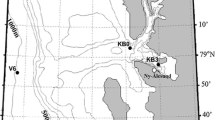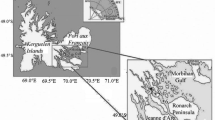Abstract
Zooplankton samples were collected in January 1993 off Dronning Maud Land along a transect from open waters to the marginal ice zone close to the Antarctic ice shelf. Thysanoessa macrura was caught in open waters while Calanoides acutus and Calanus propinquus were mainly sampled between ice floes in the marginal ice zone. The “ice-krill”Euphausia crystallorophias was found over the shelf directly associated with ice floes. T. macrura had a lipid content up to 36% of its dry weight with the dominant lipid class, wax ester, accounting for 45–50% of the total lipid. The predominance of 18:1 fatty alcohols is the striking characteristic of the wax esters. Small specimens of E. crystallorophias had lipid levels up to 26% of their dry weight with, unexpectedly, triacylglycerols being the dominant lipid (up to 41% of total lipid). The small levels of wax esters in these animals (3–6% of total lipid) had phytol as a major constituent. Large specimens of E. crystallorophias had up to 34% of their dry weight as lipid, with wax esters (47% of total lipid) dominated by 16:0 and 14:0 fatty alcohols as the major lipid. Calanus propinquus had lipid levels of up to 34% of their dry weight, with triacylglycerols (up to 63% of total lipid) being the dominant lipid. High levels of 22:1 (n-9) fatty acid were present in the triacylglycerols. Calanoides acutus had lipid levels up to 35% of the dry weight with wax esters accounting for up to 83% of total lipid. High levels of (n-3) polyunsaturated fatty acids were recorded with 20:5(n-3), 22:6(n-3) and 18:4(n-3) being the dominant moieties. On the basis of their lipid compositions we deduce that: (1) Calanoides acutus is the strictest herbivore among the four species studied, heavily utilizing the typical spring bloom; (2) T. macrura is essentially omnivorous, probably utilizing the less defined bloom situations found in oceanic waters; (3) E. crystallorophias is an omnivore well adapted to utilize both a bloom situation and to feed on ice algae and micro-zooplankton associated with the ice; (4) Calanus propinquus seems to be the most opportunistic feeder of the four species studied, probably grazing heavily on phytoplankton during a bloom and, during the rest of the year, feeding on whatever material is available, including particulates, flagellates and other ice-associated algae. We conclude that the different biochemical pathways generating large oil reserves of different compositions, enabling species to utilize different ecological niches, are major determinants of biodiversity in polar zooplankton.
Similar content being viewed by others
Author information
Authors and Affiliations
Additional information
Accepted: 22 June 1998
Rights and permissions
About this article
Cite this article
Falk-Petersen, S., Sargent, J., Lønne, O. et al. Functional biodiversity of lipids in Antarctic zooplankton: Calanoides acutus, Calanus propinquus, Thysanoessa macrura and Euphausia crystallorophias. Polar Biol 21, 37–47 (1999). https://doi.org/10.1007/s003000050330
Issue Date:
DOI: https://doi.org/10.1007/s003000050330




